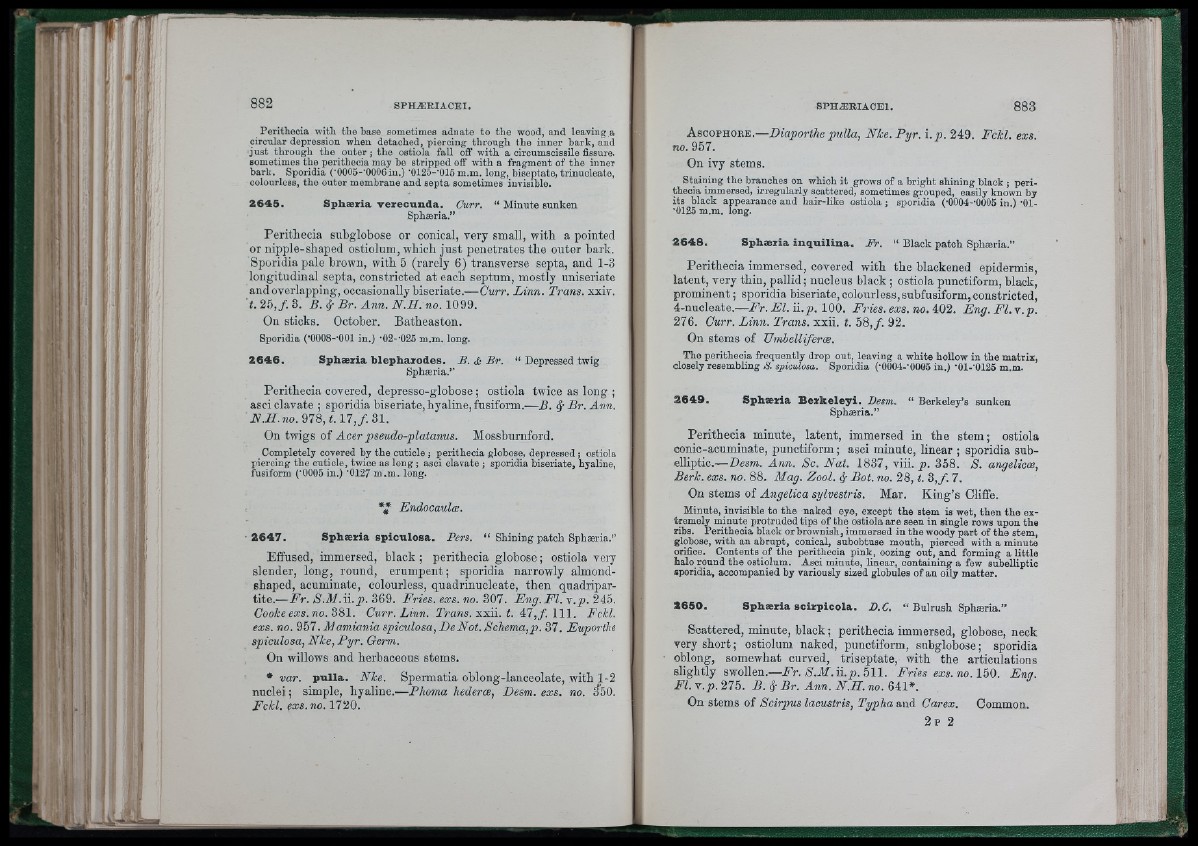
882
Perithecia witli the base sometimes adnate te the wood, and leaving a
circular depression when detached, piercing tlirough the inner bark, and
just through the outer ; the ostiola fall off with a eiroumscissile fissure,
sometimes the perithecia may be stripped off with a fragment of the inner
bark. Sporidia ('OOOS-'OOOGiu.) '0125-’015 m.m. long, biseptate, trinucleate,
colourless, the outer membrane and septa sometimes invisible.
2 6 4 5 . Sphæzia ve zecund a. Curr. “ Minute sunken
Sphæria.”
Perithecia subglobose or conical, very small, with a pointed
or nipple-shaped ostiolum, which just penetrates the outer hark.
Sporidia pale brown, with 5 (rarely 6) transverse septa, and 1-3
longitudinal septa, constricted at each septum, mostly uniseriate
and overlapping, occasionally biseriate.— Curr. Linn. Trans, xxiv.
t. 25, f . 8. B. & Br. Ann. N.H. no. 1099.
On sticks. October. Batheaston.
Sporidia {’OOOS-'OOl in.) ’02-’025 m.m. long.
2 6 4 6 . Sphæzia hlephazodes. B .& B r . “ Depressed twig
Sphæria.”
Perithecia covered, depresso-glohose ; ostiola twice as long ;
asci clavate ; sporidia biseriate, hyaline, fusiform.—B. & Br.Ann.
N.H.no. 978, i . l 7 , / .S l .
On twigs of Acer pseudo-plat anus. Mossburnford.
Completely covered hy the cuticle ; perithecia globose, depressed ; ostiola
piercing the cuticle, twice as long ; asoi clavate ; sporidia biseriate, hyaline,
fusiform ('0005 in.) '0127 m.m. long.
2 6 4 7 . Sphæzia gp iculo sa . Pers. “ Shining patch Sphæria.”
Effused, immersed, black ; perithecia globose ; ostiola very
slender, long, round, erumpent; sporidia narrowly almond-
shaped, acuminate, colourless, quadrinueleate, then quadripartite.—
Fr. S.M .ii.p . 869. Fries, exs. no. 807. Fng.Fl. Y .p . 245.
Coohe exs. no. 381. Curr. Linn. Trans, xxii. t. 41 ,f. 111. Fchl.
exs. no. 251. Mamiania spiculosa, DeNot. Schema,p. 31. Fuporthe
spiculosa, Nke, Pyr. Germ.
On willows and herbaceous stems.
* var. p u lla . Nke. Spermatia oblong-lanceolate, with 1-2
nuclei ; simple, hyaline.—Phoma hederæ, Desm. exs. no. 8'50.
Fckl. exs. no. 1720.
A s c o p h o r e .—Diaporthe pulla, Nke. Pyr. i.p . 249. Fchl. exs.
no. 957.
On ivy stems.
Staining the branches on which it grows of a bright shining black ; perithecia
immersed, irregularly scattered, sometimes grouped, easily known by
its black appearance and hair-like ostiola ; sporidia ('0004-'0005 in.) '01-
•0125 m.m. long.
2 6 4 8 . Sphæz ia in q u ilin a . Pr. “ Black patch Sphæria.”
Perithecia immersed, covered with the blackened epidermis,
latent, very thin, pallid; nucleus black ; ostiola punctiform, black,
prominent ; sporidia biseriate, colourless,subfusiform,constricted,
4-nucleate.—Fr. Fl.H. p. 100. Fries, exs. no. 402. Eng. F I .y .p.
276. Gurr. Linn. Trans, xxii. t. 58,/. 92,
On stems of Umbelliferw.
The perithecia frequently drop out, leaving a white hollow in the matrix,
closely resembling S. spiculosa. Sporidia ('0004-'0005 in.) '01-'0125 m.m.
2 6 4 9 . Sphæzia B e zk e ley i. Desm.
Sphæria.”
“ Berkeley’s sunken
Perithecia minute, latent, immersed in the stem; ostiola
conic-acuminate, punctiform ; asci minute, linear ; sporidia subelliptic.—
Desm. Ann. Sc. Nat. 1837, viii. 79. 358. S. angelicoe,
Berh. exs. no. 88. Mag. Zool. & Bot. no. 28, t. 3 ,f. 1.
On stems of Angelica sylvestris. Mar. King’s Cliffe.
Minute, invisible to the naked eye, except the stem is wet, then the extremely
minute protruded tips of the ostiola are seen in single rows upon the
ribs. Perithecia black or brownish, immersed in the woody part of the stem,
globose, with an abrupt, oonioal, subobtuse mouth, pierced with a minute
orifice. Contents of the perithecia pink, oozing out, and forming a little
halo round the ostiolum. Asci minute, linear, containing a few subelliptic
sporidia, accompanied by variously sized globules of an oily matter.
2 6 5 0 . Sphæzia sc izp ic o la . D.C. “ Bulrush Sphæria.”
Scattered, minute, black ; perithecia immersed, globose, neck
very short; ostiolum naked, punctiform, subglobose; sporidia
oblong, somewhat curved, triseptate, with the articulations
slightly swollen.—Fr. S.M .ii.p . 511. Fries exs. no. 150. Fng.
Fl. Y .p . 275. B. & Br. Ann. N.H. no. 641*.
On stems of Scirpus lacustris, Typha and Carex. Common.